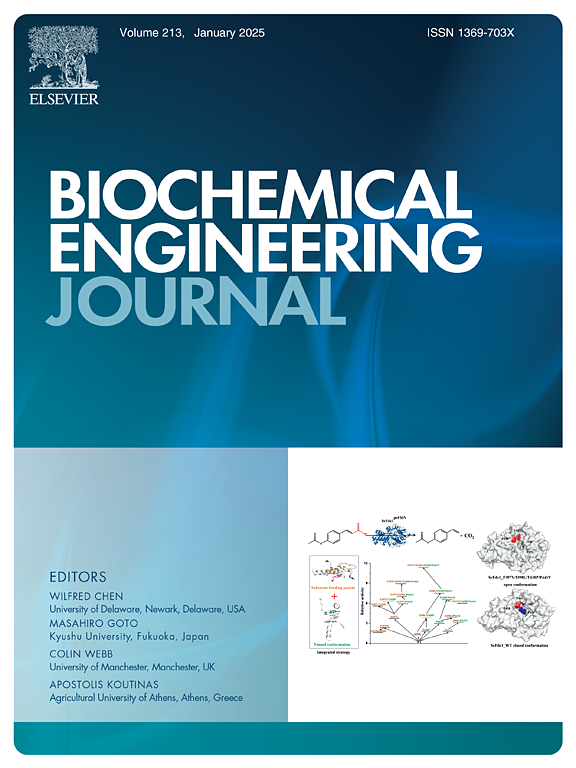设计和克隆新型人源双异位抗cd52纳米体的新策略:靶向药物传递和治疗方法的工具
IF 3.7
3区 生物学
Q2 BIOTECHNOLOGY & APPLIED MICROBIOLOGY
引用次数: 0
摘要
免疫疗法的发展是为了提高靶向癌症治疗的有效性。CD52是一种固定在细胞膜上的糖蛋白,是合适的细胞表面标记物。它在癌性淋巴样细胞中大量存在,特别是在B细胞和T细胞中,使其成为此类治疗的合适靶点。抗cd52抗体可以通过补体激活和直接细胞介导的细胞毒性诱导细胞裂解。然而,抗体的免疫原性限制了它们在人类疾病中的应用。相比之下,纳米体的独特特性使它们成为靶向治疗的理想工具。在这里,我们开发了一种新的靶向CD52的人源化双异位纳米体,称为huCD52。我们将Alemtuzumab (1ce1)和Gatralimab (6obd)的cdr氨基酸序列移植到一般人源化纳米体支架(Caplacizumab)中。我们还进行了分子对接分析和分子动力学模拟。将纳米体基因片段克隆到pET-21b(+)载体中,在大肠杆菌中表达,随后进行纯化。我们使用ELISA测试评估纳米体的结合活性。人双异位hud52纳米体与CD52蛋白具有较强的结合亲和力。我们的方法是传统协议的通用替代方案,传统协议通常需要固定或复杂的选择方法。我们已经开发了一个构建高亲和力、双异位纳米体的平台,这有可能加速针对CD52抗原呈递白血病的治疗干预的发展。本文章由计算机程序翻译,如有差异,请以英文原文为准。
New strategy for the design and cloning of novel humanized biparatopic anti-CD52 nanobodies: Tools for targeted drug delivery and therapeutic approaches
Immunotherapy has been developed to enhance the effectiveness of targeted cancer treatments. CD52 as the appropriate cell surface marker is a glycoprotein anchored to the cell membrane. It is found in large quantities in cancerous lymphoid cells, particularly in B and T cells, making it a suitable target for such therapies. Anti-CD52 antibodies can induce cell lysis through complement activation and direct cell-mediated cytotoxicity. However, the immunogenicity of antibodies limits their application in human disease. In contrast, the distinct properties of nanobodies make them ideal tools for targeted therapy. Here, we developed a novel humanized biparatopic nanobody targeting CD52, referred to as huCD52. We grafted the amino acid sequences of the CDRs from Alemtuzumab (1ce1) and Gatralimab (6obd) into a general humanized nanobody scaffold (Caplacizumab). We also conducted molecular docking analysis and molecular dynamics simulations. The nanobody gene fragment was cloned into the pET-21b(+) vector, expressed in E. coli, and subsequently purified. We evaluated the binding activity of the nanobody using the ELISA test. Human biparatopic huCD52 nanobody showed a strong binding affinity to CD52 protein. Our approach is a versatile alternative to traditional protocols, which usually require immobilization or complex selection methods. We have developed a platform for constructing high-affinity, biparatopic nanobody-based constructs, which has the potential to accelerate the development of therapeutic interventions targeting CD52 in antigen-presenting leukemia.
求助全文
通过发布文献求助,成功后即可免费获取论文全文。
去求助
来源期刊

Biochemical Engineering Journal
工程技术-工程:化工
CiteScore
7.10
自引率
5.10%
发文量
380
审稿时长
34 days
期刊介绍:
The Biochemical Engineering Journal aims to promote progress in the crucial chemical engineering aspects of the development of biological processes associated with everything from raw materials preparation to product recovery relevant to industries as diverse as medical/healthcare, industrial biotechnology, and environmental biotechnology.
The Journal welcomes full length original research papers, short communications, and review papers* in the following research fields:
Biocatalysis (enzyme or microbial) and biotransformations, including immobilized biocatalyst preparation and kinetics
Biosensors and Biodevices including biofabrication and novel fuel cell development
Bioseparations including scale-up and protein refolding/renaturation
Environmental Bioengineering including bioconversion, bioremediation, and microbial fuel cells
Bioreactor Systems including characterization, optimization and scale-up
Bioresources and Biorefinery Engineering including biomass conversion, biofuels, bioenergy, and optimization
Industrial Biotechnology including specialty chemicals, platform chemicals and neutraceuticals
Biomaterials and Tissue Engineering including bioartificial organs, cell encapsulation, and controlled release
Cell Culture Engineering (plant, animal or insect cells) including viral vectors, monoclonal antibodies, recombinant proteins, vaccines, and secondary metabolites
Cell Therapies and Stem Cells including pluripotent, mesenchymal and hematopoietic stem cells; immunotherapies; tissue-specific differentiation; and cryopreservation
Metabolic Engineering, Systems and Synthetic Biology including OMICS, bioinformatics, in silico biology, and metabolic flux analysis
Protein Engineering including enzyme engineering and directed evolution.
 求助内容:
求助内容: 应助结果提醒方式:
应助结果提醒方式:


